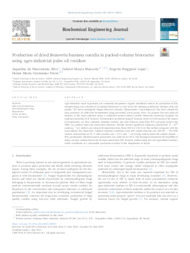Production of dried Beauveria bassiana conidia in packed-column bioreactor using agro-industrial palm oil residues.
Production of dried Beauveria bassiana conidia in packed-column bioreactor using agro-industrial palm oil residues.
Autoria: SILVA, J. do N.; MASCARIN, G. M.; LOPES, R. B.; FREIRE, D. M. G.
Resumo: Abstract: Agro-industrial waste byproducts are commonly inexpensive organic nutritional sources for production of filamentous fungi, and selection of an optimal bioreactor is a key factor for attaining satisfactory biomass yield and quality. The insect-pathogenic fungus Beauveria bassiana (Hypocreales: Cordycipitaceae) has been extensively mass produced by solid-state fermentation using precooked cereal grains. Here, we propose low-cost palm oil residues as the main substrate using a cylindrical packed-column aerobic bioreactor prototype designed for conidial production of B. bassiana. Fermentation treatments using B. bassiana strain CG1229 assessed the impact of temperature, air flow, substrate moisture content, and ratio between palm fiber (PF) and palm kernel cake (PKC) on conidial yield and desiccation tolerance. Results showed significant enhanced productivity (2 ×1010 conidia g?1 dry matter) and reduced fermentation time (from 168 h to 120 h) by this method compared with the conventional tray bioreactor. Optimal substrate conditions were 60% initial moisture and 30% PF + 70% PKC content, fermentation at 26 °C with aeration rate ? 0.2 L min?1. Air drying conidia inside the column yielded > 95% germination. Maximum spore production was achieved in 120 h. Our findings demonstrate the feasibility of using a packed-column bioreactor for mass production of B. bassiana conidia using low-cost agricultural residues, which contributes to a sustainable production method of this biopesticide in Brazil.
Ano de publicação: 2023
Tipo de publicação: Artigo de periódico
Unidade: Embrapa Meio Ambiente
Observações
1 - Por padrão são exibidas publicações dos últimos 20 anos. Para encontrar publicações mais antigas, configure o filtro ano de publicação, colocando o ano a partir do qual você deseja encontrar publicações. O filtro está na coluna da esquerda na busca acima.
2 - Para ler algumas publicações da Embrapa (apenas as que estão em formato ePub), é necessário ter, no celular ou computador, um desses softwares gratuitos. Sistemas Android: Google Play Livros; IOS: iBooks; Windows e Linux: software Calibre.
Acesse outras publicações
Acesse a Base de Dados da Pesquisa Agropecuária (BDPA) para consultar o acervo completo das bibliotecas da Embrapa.

